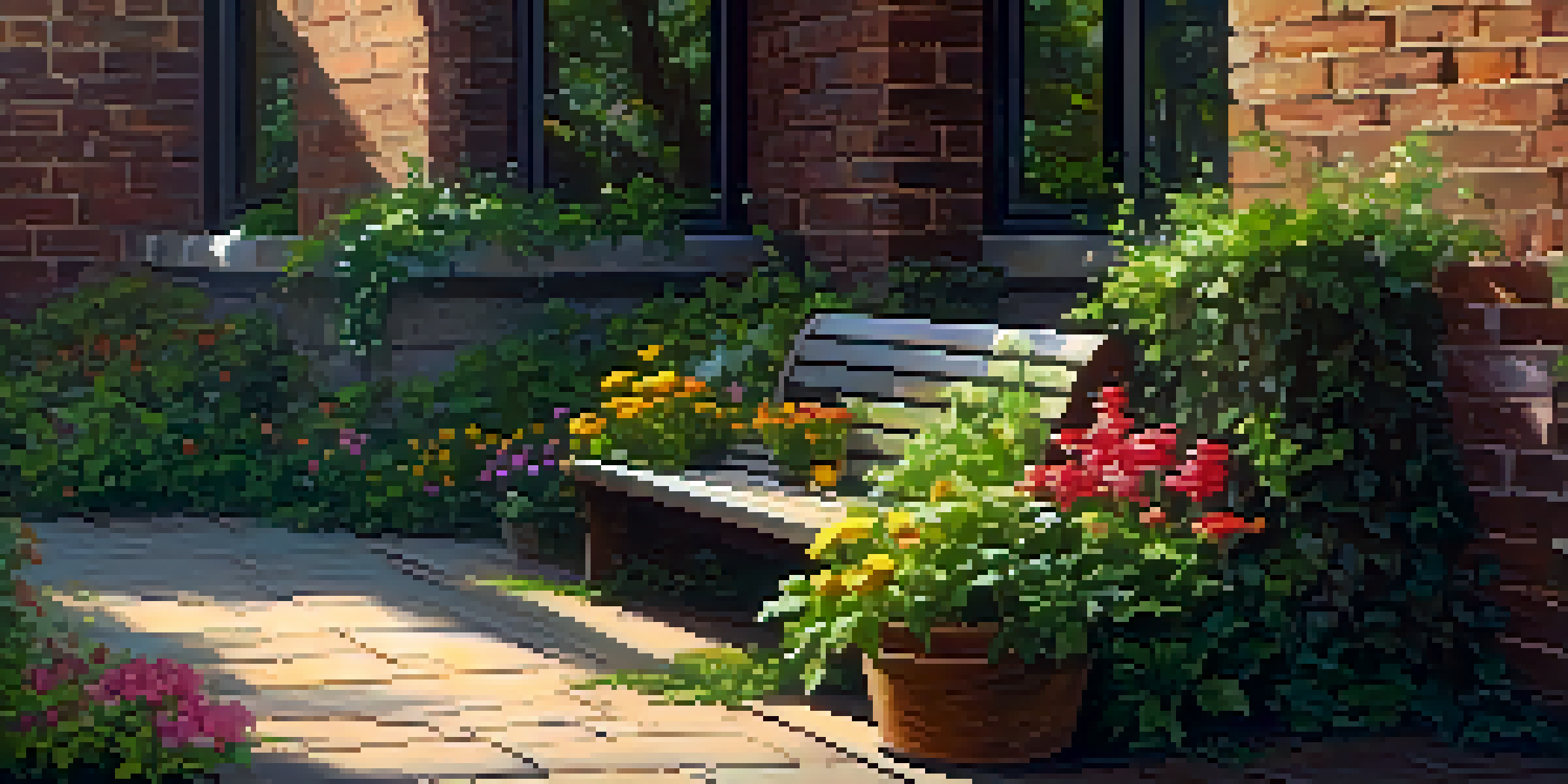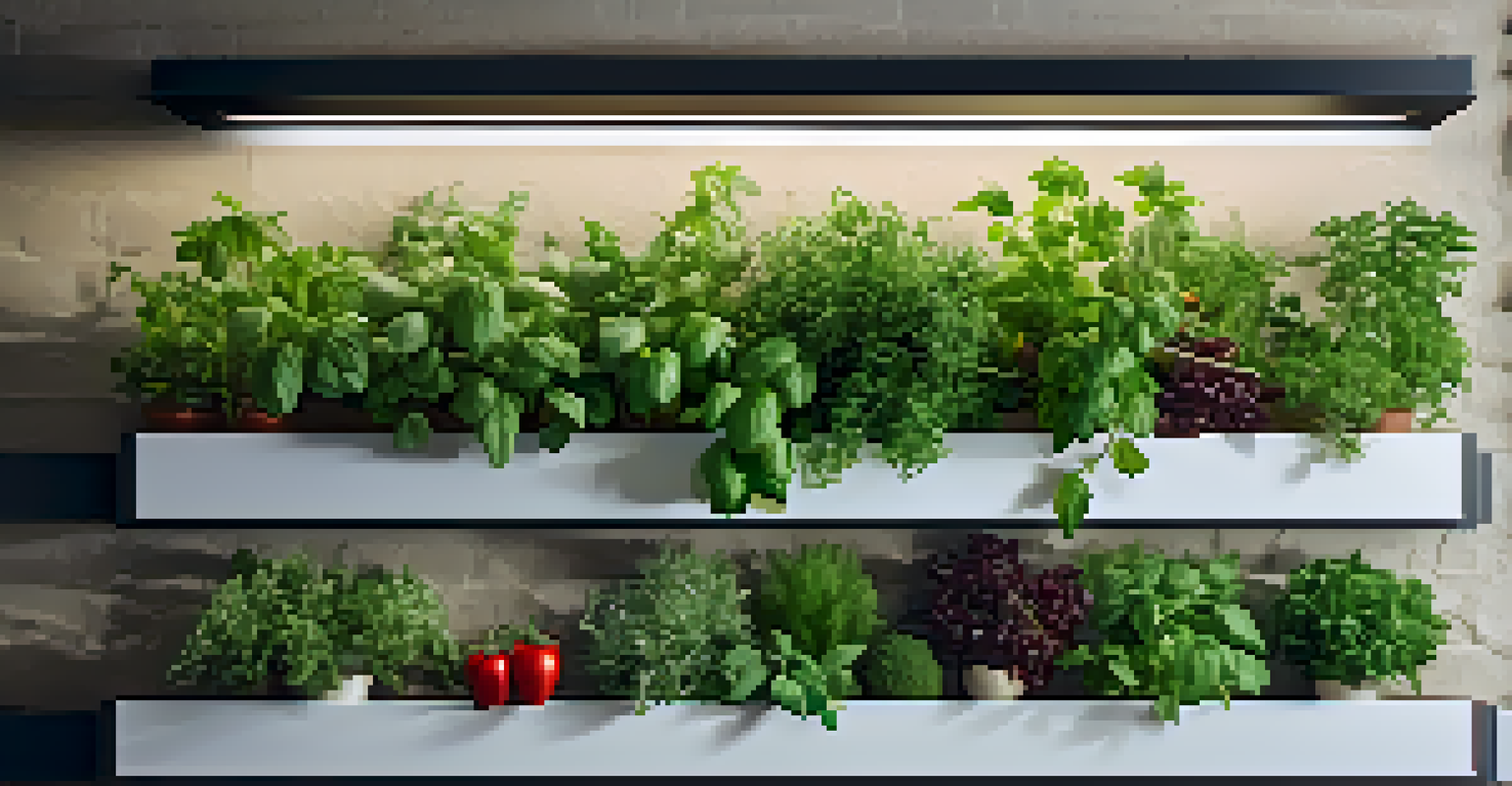Benefits of Vertical Gardening for Urban Spaces and Design

What is Vertical Gardening and Why is it Important?
Vertical gardening refers to growing plants on vertical surfaces, such as walls or trellises. This innovative approach is particularly beneficial in urban areas where space is limited. By utilizing vertical spaces, we can maximize greenery in concrete jungles, enhancing both aesthetics and air quality.
The greatest threat to our planet is the belief that someone else will save it.
The importance of vertical gardening goes beyond mere decoration; it plays a crucial role in improving urban biodiversity. It provides habitats for various species, contributing to a healthier ecosystem. Moreover, it helps mitigate the heat island effect, which is a common issue in densely populated cities.
As cities continue to grow, integrating nature into our living and working environments becomes increasingly vital. Vertical gardens not only beautify spaces but also contribute to cleaner air and improved mental well-being, making them essential for modern urban design.
Enhancing Aesthetic Appeal in Urban Environments
One of the most immediate benefits of vertical gardening is its ability to enhance the aesthetic appeal of urban spaces. Imagine a drab, grey wall transformed into a vibrant canvas of greenery and flowers. This transformation not only beautifies the environment but also creates a welcoming atmosphere for residents and visitors alike.

Vertical gardens can serve as striking focal points in public spaces, parks, and even private homes. They add color and texture, breaking up monotonous concrete and steel structures. This visual diversity is crucial in making urban areas feel more alive and connected to nature.
Enhancing Urban Aesthetics
Vertical gardens transform dull concrete spaces into vibrant green landscapes, improving the visual appeal of urban environments.
Additionally, these green installations can reflect a community's identity and values. By incorporating local plants and designs, vertical gardens can become unique expressions of culture, further engaging residents and fostering a sense of pride in their surroundings.
Improving Air Quality and Reducing Pollution
Air quality is a significant concern in urban areas, often suffering due to pollution from vehicles and industrial activities. Vertical gardens help combat this issue by filtering pollutants and producing oxygen. Plants naturally absorb carbon dioxide and other harmful gases, providing a breath of fresh air in crowded cities.
Nature does not hurry, yet everything is accomplished.
Moreover, these green spaces can significantly reduce particulate matter in the air. The leaves and soil in vertical gardens trap dust and other particles, keeping the environment cleaner. This is especially beneficial for residents living near busy roads or industrial zones.
Incorporating vertical gardens into urban design not only promotes healthier lifestyles but also encourages a greater awareness of environmental issues. As individuals see firsthand the positive impact of plants on air quality, they may be inspired to take action in other areas of sustainability.
Maximizing Space for Urban Gardening
Urbanization often leads to limited gardening space, making vertical gardening a practical solution for city dwellers. Whether you have a small balcony, limited yard space, or even just a blank wall, vertical gardening allows you to grow a variety of plants without needing extensive land. This makes it ideal for both homeowners and renters in urban settings.
Additionally, vertical gardens can be designed to fit any space or style, from simple wall-mounted planters to elaborate living walls. This adaptability means that anyone can enjoy the benefits of gardening, regardless of their living situation. It encourages urban residents to reconnect with nature and grow their own herbs, vegetables, or flowers.
Improving Air Quality
Vertical gardens filter pollutants and produce oxygen, making urban areas healthier by enhancing air quality.
By maximizing available space with vertical gardening, urban areas can transform underutilized areas into productive green spaces. This not only enhances food security but also promotes community engagement through shared gardening projects, making cities more sustainable and connected.
Promoting Mental Health and Well-Being
The connection between nature and mental health is well-documented, and vertical gardens are an excellent way to bring that connection into urban spaces. Studies have shown that exposure to greenery can reduce stress, anxiety, and depression. Vertical gardens provide an accessible way for city residents to enjoy these mental health benefits.
Having green spaces readily available can encourage people to take breaks outside, offering a serene escape from the hustle and bustle of urban life. It provides a calming environment where individuals can unwind, reflect, and recharge. Even just viewing plants can have a soothing effect, promoting overall well-being.
Moreover, engaging with gardening can also be a fulfilling hobby that fosters a sense of purpose and accomplishment. For many, nurturing plants and watching them thrive can be a rewarding experience, leading to improved mental health and a more positive outlook on life.
Supporting Biodiversity in Urban Areas
Urban environments often lack biodiversity due to the prevalence of concrete and asphalt. Vertical gardens offer a unique opportunity to support local wildlife, providing food and habitats for birds, bees, and other beneficial insects. By integrating more plants into urban areas, we can help restore some of the natural ecosystems that have been lost.
Incorporating native species into vertical gardens is especially important, as these plants are better adapted to local conditions and support local wildlife. This creates a mutually beneficial relationship where plants thrive, and wildlife is supported. It’s a small step that can lead to significant ecological improvements.
Promoting Mental Well-Being
Incorporating vertical gardens into urban settings offers mental health benefits by providing residents with accessible green spaces to relax and unwind.
By promoting biodiversity through vertical gardening, cities can become healthier environments for both residents and wildlife. It fosters an appreciation for nature and encourages individuals to participate in conservation efforts, ultimately leading to more sustainable urban living.
Sustainable Practices and Resource Efficiency
Vertical gardening is not only a trend but also a sustainable practice that can contribute to resource efficiency in urban environments. Many vertical gardens use hydroponics or aquaponics, which require less water than traditional gardening methods. This is especially crucial in cities where water conservation is a growing concern.
Additionally, vertical gardens can help regulate building temperatures, reducing the need for air conditioning and heating. By providing natural insulation, they can lower energy consumption and minimize carbon footprints. This makes them a smart choice for environmentally conscious urban design.

Promoting sustainable practices through vertical gardening also encourages communities to think more critically about their environmental impact. It inspires individuals and businesses to adopt greener practices in other areas, creating a ripple effect toward a more sustainable future.